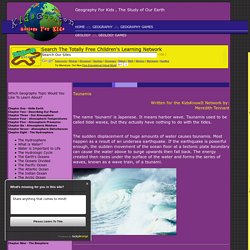

Tsunamis - Geography For Kids - By KidsGeo.com. Tsunamis Written for the KidsKnowIt Network by: Meredith Tennant The name ‘tsunami’ is Japanese.

It means harbor wave. Tsunamis used to be called tidal waves, but they actually have nothing to do with the tides. The sudden displacement of huge amounts of water causes tsunamis. A volcanic eruption can cause a tsunami. A large landslide into the water, or even a meteorite landing in the ocean, can have the same result.
The Pacific “Ring of Fire” is the most common place for tsunamis to happen, due to the number of volcanic eruptions and earthquakes. The waves of a tsunami are not the same as normal waves, which are formed by the wind. The water of a tsunami wave behaves in a very different way. Often the trough, the lowest part of the wave, reaches land first. Although it is impossible to predict a tsunami, once one is formed, early detection systems using seismic equipment and water level gauges can identify the time a wave will hit land. Facts about tsunami.
Tsunami Facts, Tsunami Information, Tsunami Videos, Tsunami Photos. A tsunami is a series of ocean waves that sends surges of water, sometimes reaching heights of over 100 feet (30.5 meters), onto land.

These walls of water can cause widespread destruction when they crash ashore. These awe-inspiring waves are typically caused by large, undersea earthquakes at tectonic plate boundaries. When the ocean floor at a plate boundary rises or falls suddenly it displaces the water above it and launches the rolling waves that will become a tsunami. Most tsunamis, about 80 percent, happen within the Pacific Ocean’s “Ring of Fire,” a geologically active area where tectonic shifts make volcanoes and earthquakes common. Tsunamis may also be caused by underwater landslides or volcanic eruptions. Tsunamis race across the sea at up to 500 miles (805 kilometers) an hour—about as fast as a jet airplane. In deep ocean, tsunami waves may appear only a foot or so high. A tsunami’s trough, the low point beneath the wave’s crest, often reaches shore first. How tsunamis are made. Tell Me - How do tsunamis develop?
50 Tsunami Facts. Tsunami Facts for Kids - Interesting Information about Tsunamis. Tsunami watch lifted after Pacific quake - National News. Published: 2:43PM Wednesday February 06, 2013 Source: ONE News Civil Defence have lifted the tsunami threat warning for New Zealand after a magnitude 8 earthquake struck off the coast of the Solomon Islands.

Director of Civil Defence John Hamilton says although emergency operation centres have now been closed down across country, there may continue to be some risk, however it is not significant enough to keep the warning in place. Officials are warning there could be surges along the West Coast of New Zealand for up to 48 hours and that people should exercise caution and discretion before entering the water or going out in small boats.
The modelling indicated there is a possibility of there being surges and tidal changes particularly in the very narrow and confined water ways such as around Charleston and Jacksons Bay and the Greymouth/Westport areas, says Hamilton. Five people, including a boy, were killed when the tsunami struck in the Solomon Islands today. Tsunami facts (Height, location, how they move, how fast they go)